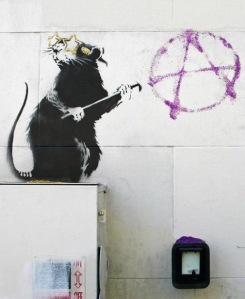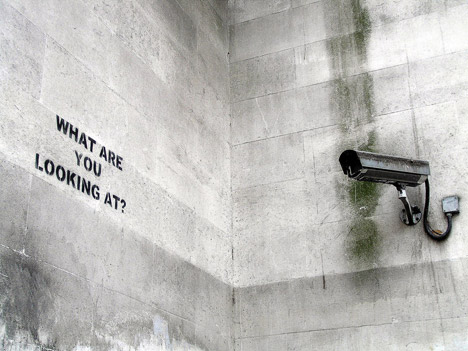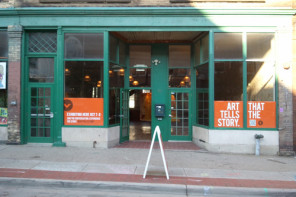Frustration with the state of ‘modern’ art sometimes leads Christians to long nostalgically for the days of the ‘anonymous medieval craftsman.’ Those were the days when men were men, and artists, well … weren’t. The ‘great artist,’ it is often observed, is a modern social construct that praises the individuality, freedom and mysterious skill of a person who (if we are really being honest) is no ‘greater’ than our humble medieval craftsman. The modern artist, it would seem, needs a spoonful of humble medicine, and, perhaps, a return to anonymity could do him some good.
This is precisely when our newly installed ‘historical context’ alarm should start blaring. Does anonymity always mean the same thing in 2010 that it did in 1310? As an example of a contemporary anonymous artist, consider the work of Banksy (see this website). To my knowledge, his identity remains unknown. Banksy is a ‘famous’ graffiti artist whose work often combines humor with clever political content. His works appear in a remarkable variety of places (indoors and outdoors) typically within the urban environment. Usually he works in the dark of night, but he has also found ways to work in broad daylight. His paintings often draw attention to the fact that they are, pure and simple, vandalism. But they are a vandalism that has attracted a large and sophisticated adoring public.
 Although it would seem that anonymity divests Banksy of the trappings of the ‘modern artist,’ in certain respects he perpetuates this myth. First, by working anonymously he extricates himself from the power structures that govern the art world, and even those that govern western liberal democracy. He is, in a strange sense, a fugitive, but this freedom from modern systematization and conformity entices us and holds before us a kind of redemption from mundane life that is not dissimilar from the freedom exemplified by the ‘great modern artist.’ Second, like the modern artist whose talent baffles and extends beyond skill and tradition, we are mystified by the impossibility of these paintings. How has he not been caught?
Although it would seem that anonymity divests Banksy of the trappings of the ‘modern artist,’ in certain respects he perpetuates this myth. First, by working anonymously he extricates himself from the power structures that govern the art world, and even those that govern western liberal democracy. He is, in a strange sense, a fugitive, but this freedom from modern systematization and conformity entices us and holds before us a kind of redemption from mundane life that is not dissimilar from the freedom exemplified by the ‘great modern artist.’ Second, like the modern artist whose talent baffles and extends beyond skill and tradition, we are mystified by the impossibility of these paintings. How has he not been caught?
The point is that the ‘anonymous craftsman’ must be considered within a modern context, and this has to take into account our society’s obsession with statistics, identification, and surveillance. To be anonymous, in contemporary society, is inherently destabilizing because if one is not known then one cannot be controlled. And the romantic notion of the artist assumes precisely this same social role for the artist. But sometimes destabilizing forces are needed, especially when systems of power become corrupt. The world needs its enigmatic revolutionaries, anonymous or not.
Image Credits: banksy.co.uk and toxicocultura.com






Interesting. The anonymous artist idea historically is certainly more along the lines of someone not attempting to preserve works as his (e.g. not signing them). But everyone would have known that he had been hired to paint a particular painting, make a particular sculpture, etc. Banksy seems to be the reverse: he has a recognizable body of work clearly connected to his identity, but no one knows what that identity is.
Ben, thanks for this comment. As you point out, it is definitely important to recognize the way in which an artist is being anonymous. It is certainly true that anonymity can be a way to avoid preserving one’s works as one’s own. In this sense it might be considered humble. However, Banksy could be connected to the very long tradition of writing under a pseudonym (in the visual arts think of all the controversies over whether this or that painting is actually a Rembrandt or a product of one of his students). Some pseudonymous writing would certainly fit your description of Banksy. But, more importantly, pseudonymous writing attributes the work to someone else (be that a fictitious or real person). While it could be considered a humble act to write in the tradition of a great author or thinker (and so sign the work in their name), this is in fact the very destabilizing element that one finds in Banksy — his identity is ambiguous.